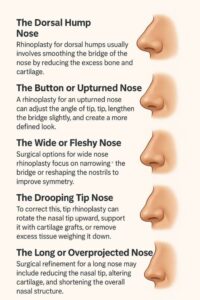Everyone’s nose is different, and that’s just one of the many things that make each face so unique! But for anyone thinking about making a change, a nose job is a commonly explored option. And, for those who decide to undergo the nose job, understanding nose shapes and how they influence your surgical options is the very first step.
In this blog, we’re exploring six different nose shapes and their accompanying surgery options so you can make a better, more informed decision with the help of your plastic surgeon. With that in mind, let’s take a closer look at some of the most common nose shapes and what they mean for your potential rhinoplasty plan.
6 Different Nose Shapes and Their Accompanying Surgery Options
Noses come in many shapes and sizes, but some features tend to show up more frequently than others. The key is knowing how a skilled plastic surgeon can address each shape to create balance and harmony across your entire face.
Below are six nose types patients most commonly ask about, along with the rhinoplasty techniques typically used to reshape, refine, or reposition them.
1. The Dorsal Hump Nose
One of the most common concerns people bring to a plastic surgeon is the dorsal hump, essentially a noticeable bump along the bridge of the nose. This feature can be genetic or the result of injury, and while some people embrace their new bump, others may feel it interrupts the flow of their profile.
Rhinoplasty for dorsal humps usually involves smoothing the bridge of the nose by reducing the excess bone and cartilage. The surgeon may also refine the nasal tip to match the newly streamlined look, which helps make sure that your entire nose remains in proportion with your other features.
2. The Button or Upturned Nose
The upturned or “button” nose features a rounded tip that angles upward. This shape is often associated with a youthful or playful appearance, but in some cases, the nostrils may appear overly exposed.
A rhinoplasty for an upturned nose can adjust the angle of the tip, lengthen the bridge slightly, and create a more defined look, particularly if the patient feels the shape detracts from a more mature or elegant aesthetic.
3. The Wide or Fleshy Nose
A wide nose often has a broader bridge, tip, or nostrils. This shape may feel out of balance with more delicate facial features or may be a cultural trait that someone wants to subtly refine.
Surgical options for wide nose rhinoplasty focus on narrowing the bridge or reshaping the nostrils to improve symmetry. In some cases, cartilage grafting may be used to add structure and create more definition across the nasal tip.
4. The Drooping Tip Nose
A drooping tip nose points downward, especially noticeable when smiling. This shape may be present from birth or develop over time due to aging, which can weaken nasal support structures.
To correct this, tip rhinoplasty can rotate the nasal tip upward, support it with cartilage grafts, or remove excess tissue weighing it down. The result is a more lifted, refined appearance that better supports a youthful expression.
5. The Crooked Nose
Crooked noses can be caused by genetics, injury, or a deviated septum. In many cases, they result in both cosmetic and functional issues, including breathing difficulties or asymmetry that affects facial balance.
Rhinoplasty for a crooked nose typically involves both cosmetic realignment and internal structural correction. In these cases, a surgeon may recommend combining cosmetic changes with septoplasty to ensure both appearance and breathing are improved.
6. The Long or Overprojected Nose
A nose that appears too long or projects significantly from the face can sometimes dominate your overall look. Patients often seek to reduce projection or shorten the nose while preserving their natural character.
Surgical refinement for a long nose may include reducing the nasal tip, altering cartilage, and shortening the overall nasal structure. An experienced plastic surgeon will carefully sculpt the nose to sit more harmoniously with the chin, cheeks, and eyes.
Considering Ethnic and Cultural Features
It’s also important to remember that nose shapes are often tied to ethnicity, and a good plastic surgeon will honor your background and identity. For patients looking for ethnic rhinoplasty, the approach focuses on refining features without erasing heritage, something Dr. Dhir is deeply experienced in.
A customized, culturally sensitive plan can help you achieve your desired aesthetic while preserving the essence of what makes you you.
Ready to Explore Your Rhinoplasty Options?
Let Dr. Dhir help you feel confident in your skin. Schedule a consultation today to explore your options with one of the most experienced plastic surgeon in the area and discover the best approach for your unique nose shape.


